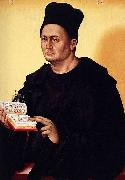Jan Polack Johannes Po(l)lack (Hanns Polagk, Polegk), (Latin: Ioannes Polonus) (between 1435 and 1450 (possibly in Krakew) - 1519 in Munich) was a 15th-century painter.
From his nickname it is assumed that he might have worked in Krakew. From the mid-1470s on, he lived and worked in Munich, having previously been in Franconia. He may have taken part in the 1475 festival of the Landshut Wedding of Jadwiga Jagiellon and George of Bavaria. In 1480 he opened his own shop in Munich.
Starting in 1482 he is listed on the tax records of Munich, also as leader of the local painter guild. He visited with Michael Wohlgemuth and his art was influenced by him and by that of Veit Stoss and Hans Pleydenwurff as well as by collaboration with the woodcutter Erasmus Grasser.
Documents mention many works of his which are now lost. His most important remaining work is the Weihenstephan altarpiece (1483 - 1485), now at the Alte Pinakothek in Munich.








